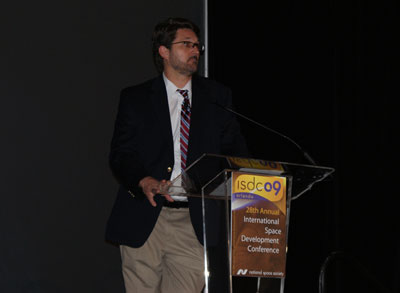Space and (or versus) the environmentby Jeff Foust
|
| “Less fuel and clean fuel: this all adds up to a space launch system which will be completely unprecedented in its low environmental impact,” said Branson. |
The environment has been something that the spaceport’s anchor tenant, Virgin Galactic, has taken pains to address in the last couple of years. On a number of occasions the company has noted that the suborbital system it is developing not only has a relatively low environmental impact but also could serve as the precursor for future orbital launch systems that could in the long run greatly benefit the environment. This emphasis dates at least as far back as September 2006, when Virgin noted that the carbon emissions of a single SpaceShipTwo (SS2) flight would be equivalent to that produced by a single business-class seat on a New York-to-London Virgin Atlantic flight (see “A sneak peek inside SpaceShipTwo”, The Space Review, October 2, 2006). Those numbers have been revised somewhat: Virgin marketing materials now claim that that the CO2 emissions on a SS2 flight will be 25% less per person than for a typical commercial New York-to-London flight.
That theme came up again last month, when Virgin Galactic announced the completion of the first round of tests of the hybrid rocket motor that will power SS2. In a video accompanying the announcement, Sir Richard Branson noted the benefits of that hybrid rocket motor as well as the air-launched nature of the system. “This means much less fuel is required, fuel which provides none of the toxins that are present in the solid rockets used by the space shuttle and satellite launchers,” Branson said. “Less fuel and clean fuel: this all adds up to a space launch system which will be completely unprecedented in its low environmental impact.”
“If we can get robust, safe, and more importantly, environmentally benign access to space, we can do things up there that were never imagined a few years ago,” said Virgin Galactic president Will Whitehorn in the video. “We can put server farms in space. We can run our agricultural systems from space. We can provide solar power from space.”
However, Virgin has been far from free of criticism about the environmental impact of its plans. Earlier last month Leo Hickman, a journalist who covers environmental issues for The Guardian newspaper, criticized Virgin for playing up the environmental benefits of its system. “Why doesn’t Virgin Galactic just call it as it is?” he concluded in a May 11 blog entry. “Sure, sell your dreams of space flight to the super-rich if you must… but let’s not keep up the pretence that it isn’t one of the most extravagant and self-centred uses of a fossil fuel imaginable.”
Earlier this year Australian environmentalist Tim Flannery, serving as a consultant to Virgin, said Virgin’s work was important to raising awareness about the environment and could also lead to a “more energy-efficient option” for long-haul airline flights. Flannery was then criticized by his fellow environmentalists for taking part in “an extreme form of greenwashing” by working with Virgin. “Tim does great work … [but] flying in space will never be sustainable,” said Cate Faehrmann, executive director of the Nature Conservation Council of New South Wales.
The ozone issue
Much of the concern about the environmental friendliness (or lack thereof) of space tourism systems like Virgin Galactic’s has focused on the greenhouse gas emissions of such vehicles. However, despite claims of “untold” amounts of emissions, it’s hard to see suborbital spaceflights as being a major contributor of emissions for the foreseeable future provided Virgin’s emission calculations are correct (and applicable to other companies developing suborbital systems.) Even at traffic levels of 10,000 passengers a year (a rate likely not achieved for several years to come even in the most optimistic scenarios), the annual emissions from such vehicles would still be a minute fraction of the daily emissions from commercial aviation.
However, another environmental concern might loom large in the years to come: the effect of suborbital spaceflight on the ozone layer. A generation ago the depletion of the ozone layer by chlorofluorocarbons (CFCs) was a major concern, leading to international agreements to ban the use of such chemicals. As a result, the ozone layer is starting to rebound, and current models project a complete recovery by 2040.
Launch vehicles don’t emit CFCs, but they do release other combustion byproducts that can affect the ozone layer. Moreover, these materials are injected directly into the ozone layer as rockets ascend into space, a far more efficient delivery mechanism than the atmospheric processes that slowly waft ground emissions into the stratosphere.
| “It would be disingenuous for anyone in this arena to tell you that they’re going to do a ‘100% green everything’ launch,” Pickens said. |
Right now, such emissions are insignificant. In a paper published earlier this year in the journal Astropolitics, researchers at the Aerospace Corporation, University of Colorado, and Embry-Riddle Aeronautical University noted that rocket launches worldwide deplete the ozone layer currently at a rate of 0.03%, a rate they described as “insignificant”. Different rockets, and different combinations of propellants, have varying contributions: solid-fuel rockets have a greater impact than liquid-propellant engines, and systems that use liquid oxygen (LOX) as an oxidizer (in combination with liquid hydrogen or kerosene) have a greater effect than hypergolics. The paper notes that the Ariane 5, which has solid-rocket boosters and a LOX/liquid hydrogen main engine, likely causes about 25 times the ozone loss as one of its biggest competitors on the commercial launch market, the Proton, which uses unsymmetrical dimethyl hydrazine and nitrogen tetroxide—a combination that, ironically, is usually considered environmentally unfriendly given the propellants’ toxic nature.
While the current rate of ozone loss is considered insignificant, the paper examined what would happen if there was a sharp increase in launch rates. If launch rates doubled every decade, they found, rising emissions from rockets would offset the decline in other ozone-depleting substances by around 2035, causing ozone depletion rates to rise again. The effect would be sooner and sharper if launch rates tripled every decade. The authors conclude that, in such a scenario, there would be a move to regulate rocket emissions that could, in the worst case, sharply restrict launch activity.
With today’s launch systems, though, such an outcome seems unlikely: most forecasts for the next decade project relatively flat levels of launch activity—about 60–70 orbital launches a year—that is far short of a doubling or tripling. However, a wild card here is space tourism and other suborbital launch activity, which is projected to grow from effectively zero today to hundreds or even thousands of launches a year by the end of the next decade, if systems enter service as planned and demand for such flights matches existing projections.
The Astropolitics paper doesn’t take such missions, or interest in point-to-point suborbital or hypersonic travel, into account. Martin Ross, lead author of the paper at the Aerospace Corporation, said in an email last week that this is an area they will be looking at. They will also be studying the effect on ozone by emissions from hybrid rocket motors like the one being developed for SS2, something that he said there currently isn’t any information about.
In an op-ed in last week’s issue of Space News, Ross urged the space industry to address this issue head-on rather than avoid it in the hopes it might go away on its own. “It is clear that the risk of regulation that would cap or even tax space systems according to the amount of ozone depletion they cause is small, but it is real,” he wrote. He added: “Historically, technical activities with high visibility—such as space operations—often excite unpredictable public and regulatory attention. Combined with a lack of scientifically reliable environmental effects data, the risk of idiosyncratic and overly restrictive regulation is high.”
 Tim Pickens of Orion Propulsion discusses his company’s efforts in “greening” aerospace at the International Space Development Conference last month. (credit: J. Foust) |
Greening aerospace
The aerospace industry in general has not had a good track record in being environmentally friendly, Tim Pickens, CEO of Orion Propulsion, said in a speech on “greening aerospace” at the International Space Development Conference (ISDC) in Orlando last month. Launch vehicles for many years used toxic propellants and left behind contamination like perchlorates. “They did that for good reasons at the time,” he said. “We’re still paying the price for that today in a lot of ways.”
| “It is clear that the risk of regulation that would cap or even tax space systems according to the amount of ozone depletion they cause is small, but it is real,” Ross wrote in a recent op-ed. |
Orion, he said, was trying to avoid that legacy by developing systems that were more environmentally friendly. One example is an attitude control system the company is developing for Bigelow Aerospace’s Sundancer module. Rather than use a storable hypergolic like hydrazine—a common choice for such thrusters—Orion will take waste water from the module’s environmental control and life support system (ECLSS) and break it down into hydrogen and oxygen, which will be used as the thrusters’ propellants. “Some people say, ‘so you’re burning urine?’” Pickens said. “And I say, well, we’re burning urine. Yeah, we’re going to be doing that. And that’s pretty cool.”
He is, though, critical of space ventures that try to wrap themselves in an environmental cloak. “I don’t think it’s genuine to say, ‘I am saving the environment by hauling people up for fun,’” he said in comments after his ISDC speech, not mentioning any specific company. “I don’t think it will be anything you can sell to the public by saying that you’re only putting out so much CO2 and you’re green. No one’s going to buy into that.”
“It would be disingenuous for anyone in this arena to tell you that they’re going to do a ‘100% green everything’ launch,” Pickens said in his speech. The question remains, though, just how green—in terms of carbon footprint, emission of ozone-depleting substances, and other matters—existing and emerging space ventures have to be to satisfy a society that has become increasingly concerned about civilization’s impact on the environment.
